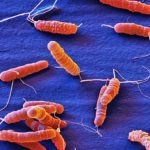Lien vers Pubmed [PMID] – 16895946
Mutagenesis 2006 Sep;21(5):305-11
Nitrofurans are widely used in human medicine, as nitrofurantoin and nifuroxazide, still prescribed for long-term antimicrobial prophylaxis of urinary tract and gastrointestinal infection in humans respectively. Recent experiments in mammals, as well as reports mentioning toxic effects in humans associated with a long-term use, specially in the case of nitrofurantoin, raised the need for reevaluating their genotoxicity. The objective of this study was to determine whether these two compounds induce a mutagenic effect in the Big Blue transgenic mouse mutation assay. Mice were orally treated either with nitrofurantoin or nifuroxazide for five consecutive days and sacrificed 3 weeks later. In order to optimize the genotoxic response, the doses used for each compound were 25-fold higher as the posology in humans. They corresponded to 50% of the highest doses tolerated by mice. The mutant frequency was determined from kidney, lung, bladder, caecum, colon, small intestine, spleen and stomach. A weak mutagenic response of nitrofurantoin-treated mice specifically in the kidney was observed. As in the case of other nitrofuran compounds, the mutation spectra determined from treated samples exhibited slightly more GC–>TA transversions as compared with untreated conditions. These data are relevant to the targeted action of nitrofurantoin as a urinary antimicrobial agent. No significant increase of mutants was detected in the case of nifuroxazide-treated mice whatever the organs analysed.


